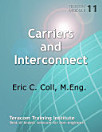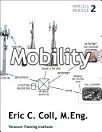Wireless Telecommunications
À propos de cet e-book
In this comprehensive module, you will learn all about wireless transmission, beginning with the radio spectrum.
We’ll identify the components and basic principles of operation of a mobile network. You’ll understand the requirements for coverage, capacity and mobility, and why cellular radio systems are used.
You’ll learn how mobile to PSTN phone calls are connected, how mobile Internet works, along with roaming and virtual network operators.
You’ll learn about OFDMA, 4G LTE and 5G for mobile, and for 3.5 GHz fixed wireless home internet.
We’ll cover WiFi and the latest Wi-Fi 6 802.11ax standard, and finish with satellite communications and Starlink.
Telecom Module 7
Detailed Outline
7 Wireless Telecommunications
7.1 Radio
7.2 Spectrum
..... 7.2.1 The Need for Regulation
..... 7.2.2 Radio Spectrum
..... 7.2.3 Capacity vsPerformance Tradeoff
..... 7.2.4 Two-Way Radio: FDD or TDD
..... 7.2.5 Frequency Bands
..... 7.2.6 600 MHz Band
..... 7.2.7 700 MHz Band
..... 7.2.8 800, 900, 1800 and 1900 MHz bands
..... 7.2.9 2.4 GHz and 5 GHz Unlicensed Bands
..... 7.2.10 2.5 GHz Band
..... 7.2.11 3.5 GHz Band
..... 7.2.12 3.7 GHz C-Band 5G
..... 7.2.13 Millimeter-Wave Bands
7.3 Mobile Network Components and Operation
..... 7.3.1 0G: The Mobile Phone System
..... 7.3.2 Mobility
..... 7.3.3 Base Station, Cell, Airlink, Handset and SIM
..... 7.3.4 Mobile Switch
..... 7.3.5 Backhaul
..... 7.3.6 Registration and Paging
..... 7.3.7 Handoff
7.4 Cellular Principles
..... 7.4.1 AMPS: The Advanced Mobile Phone System
..... 7.4.2 Cells
..... 7.4.3 Frequency Re-Use
..... 7.4.4 1G: Analog Frequency-Division Multiple Access
..... 7.4.7 Sectorization
7.5 Second Generation: Digital
..... 7.5.1 PCS and GSM
7.6 PSTN Phone Calls using the Phone App: “Voice Minutes”
..... 7.6.1 The Native Telephone App
..... 7.6.2 Speech Digitized and Packetized in the Phone
..... 7.6.3 Radio Frequency Modem
..... 7.6.4 Antenna
..... 7.6.5 The Base Station
..... 7.6.6 Backhaul to Mobile Switch and Call Routing
..... 7.6.7 Speech Coding Standards and Bit Rates
..... 7.6.8 Connection to the PSTN
7.7 Mobile Internet: “Data Plan”
..... 7.7.1 Cellphone as a Tethered Modem
..... 7.7.2 Mobile Wi-Fi Hotspot
..... 7.7.3 Packet Relay to the Internet
..... 7.7.4 Dongles
..... 7.7.5 Smartphone as the Terminal
..... 7.7.6 Billing Plans and Roaming
..... 7.7.7 The Holy Grail of Convergence
7.8 Mobile Operators, MVNOs and Roaming
7.9 3G: CDMA and HSPA
..... 7.9.1 IMT-2000
..... 7.9.2 1X or CDMA2000: IMT-MC
..... 7.9.3 UMTS or W-CDMA: IMT-DS
..... 7.9.4 Data-Optimized Carriers: HSPA and EV-DO
..... 7.9.5 The End of the Standards War
7.10 4G LTE: Mobile Broadband
..... 7.10.1 Universal Terrestrial Radio Access Network Long-Term Evolution
..... 7.10.2 Radio Resource Controller
..... 7.10.3 OFDM
..... 7.10.4 3GPP Standards Committees
..... 7.10.5 Qualcomm Patents
7.11 5G NR: Enhanced Mobile Broadband, IoT Communications
7.12 Spectrum-Sharing Roundup: FDMA, TDMA, CDMA, OFDMA
7.13 3.5-GHz Fixed Wireless Broadband Home Internet
7.14 Wi-Fi: 802.11 Wireless LANs
..... 7.14.1 System Components
..... 7.14.2 Service Set ID
..... 7.14.3 Unlicensed Radio Bands
..... 7.14.4 Half-Duplex
..... 7.14.5 802.11b and g
..... 7.14.6 802.11a
..... 7.14.7 Wi-Fi 4: 802.11n
..... 7.14.8 Wi-Fi 5: 802.11ac
..... 7.14.9 Wi-Fi 6: 802.11ax
..... 7.14.10 VoIP over Wireless LANs
..... 7.14.11 Wi-Fi Security
7.15 Communication Satellites
..... 7.15.1 Transponders
..... 7.15.2 Geosynchronous Orbit
..... 7.15.3 Low Earth Orbit
..... 7.15.6 Starlink
À propos de l'auteur
Eric Coll is an international expert in telecommunications, broadband and networking, and has been actively involved in the telecom industry since 1983. He holds Bachelor of Engineering and Master of Engineering (Electrical) degrees.
Mr. Coll has broad experience, and broad knowledge of telecom developed working as an engineer in the telecommunications industry.
He has used his knowledge of telecom to develop and teach telecommunications technology training seminars to wide acclaim across North America since 1992... and answering questions at seminars for companies and organizations ranging from Bell Labs to the Department of Justice keeps things up to date.
In his spare time, Mr. Coll authors textbooks and online courses based on the latest updates to the seminar courses.
Mr. Coll also provides consulting services as a Subject Matter Expert in telecommunications to government, carriers, and their customers.









